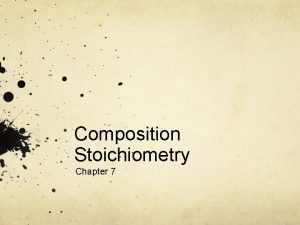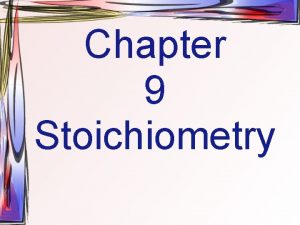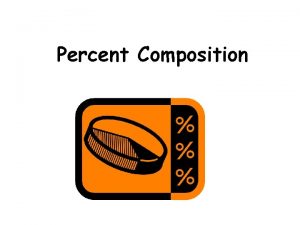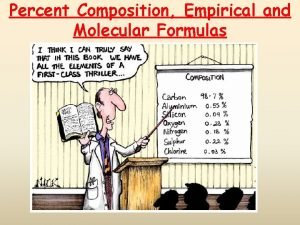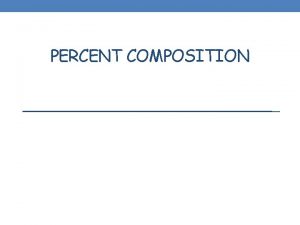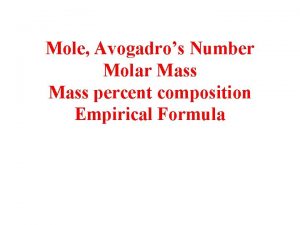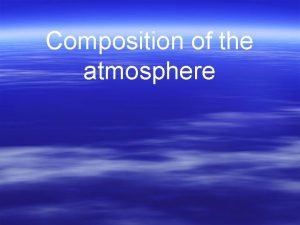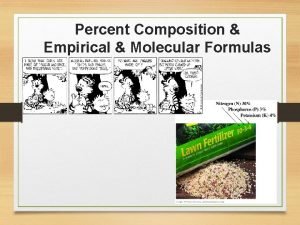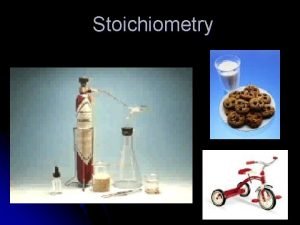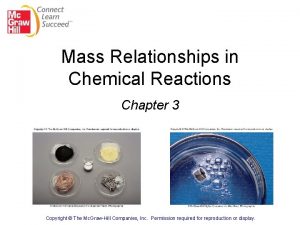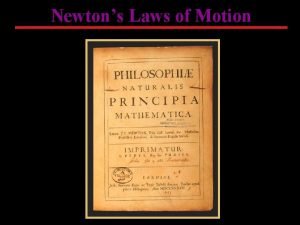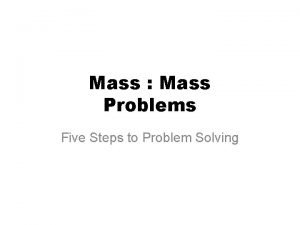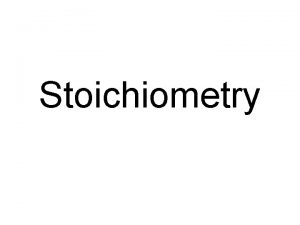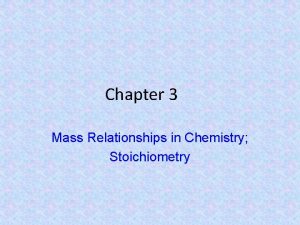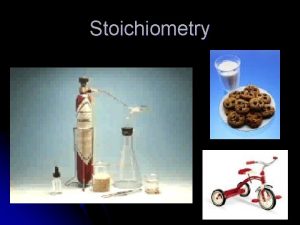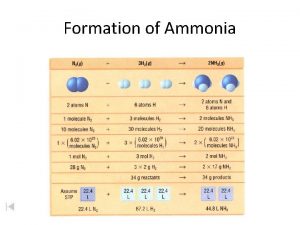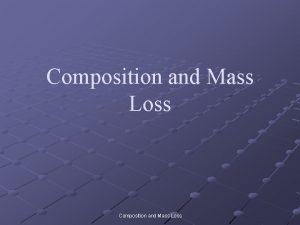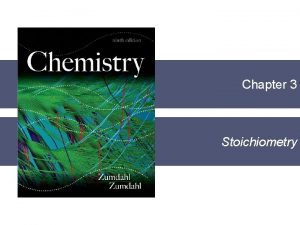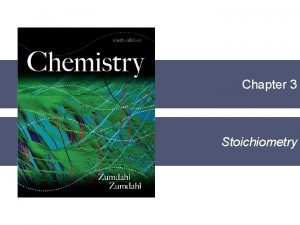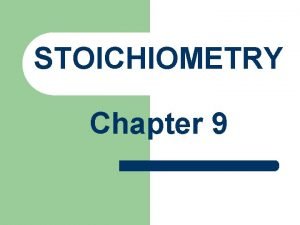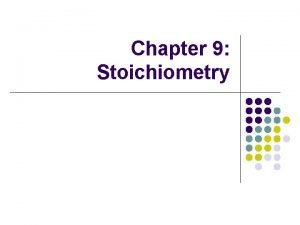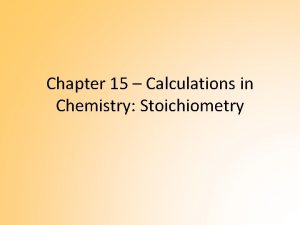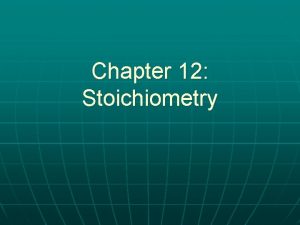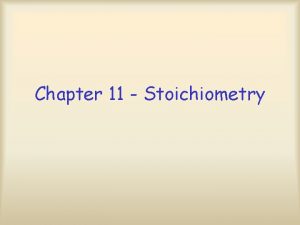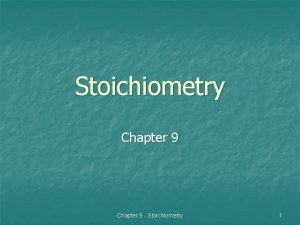Chapter 9 Stoichiometry Stoichiometry Composition stoichiometry Mass relationships




























- Slides: 28

Chapter 9 Stoichiometry

Stoichiometry • Composition stoichiometry – Mass relationships of elements in compounds • Reaction stoichiometry – Mass relationships between reactants and products

Reaction Stoichiometry • Use ratios from balanced equation • Problem Type 1 – Given & unknown quantities in moles • Problem Type 2 – Given in moles & unknown in grams

Reaction Stoichiometry • Problem Type 3 – Given in grams & unknown in moles • Problem Type 4 – Given in grams & unknown in grams

Mole Ratio • Conversion factor that relates amount of moles of substances 2 Al 2 O 3(l) 4 Al(s) + 3 O 2(g) • How many moles of aluminum can be produced from 13. 0 mol of aluminum oxide?

Molar Mass • The mass (in g) of 1 mole of substance 2 Al 2 O 3(l) 4 Al(s) + 3 O 2(g) • How many grams of Al is equivalent to 26. 0 mol Al?

Conversions • Problem Type 1 – Mole to mole – One conversion factor: mole ratio • Given (mol) x mole ratio (mol/mol) = unknown (mol)

Conversions • In a spacecraft, the CO 2 exhaled by astronauts can be removed by its reaction with lithium hydroxide, Li. OH, according to the following chemical equation. CO 2(g) + 2 Li. OH(s) Li 2 CO 3(s) + H 2 O(l) • How many moles of Li. OH are required to react with 20 mol of CO 2, the average amount exhaled by a person each day?

Conversions • The disinfectant hydrogen peroxide, H 2 O 2, decomposes to form water and oxygen gas. How many moles of O 2, will result from the decomposition of 5 mol of hydrogen peroxide?

Conversions • Problem Type 2 – Mole to mass – Two conversion factors: mole ratio & molar mass • Given (mol) x mole ratio (mol/mol) x molar mass (g/mol) = unknown (g)

Conversions • In photosynthesis, plants use energy from the sun to produce glucose C 6 H 12 O 6, and oxygen from the reaction of CO 2 and H 2 O. What mass, in grams, of glucose is produced when 3. 00 mol of H 2 O with CO 2?

Conversions • What mass of CO 2, in grams, is needed to react with 3. 00 mol of H 2 O in the photosynthetic reaction described on the last slide?

Conversions • Problem Type 3 – Mass to moles – Two conversion factors: molar mass & mole ratio • Given (g) x molar mass (mol/g) x mole ratio (mol/mol) = unknown (mol)

Conversions • The first step in the industrial manufacture of nitric acid is the catalytic oxidation of ammonia, NH 3(g) + O 2(g) NO(g) + H 2 O(g) (unbalanced) The reaction is run using 824 g of NH 3 and excess oxygen. a. How many moles of NO are formed? b. How many moles of H 2 O are formed?

Conversions • The compound Pt. Cl 2(NH 3)2 is effective as a treatment for some cancers. It is synthesized by the reaction shown in the following equation: K 2 Pt. Cl 4 + 2 NH 3 2 KCl + Pt. Cl 2(NH 3)2 a. How many moles of K 2 Pt. Cl 4 must react in order to produce 30. 0 g of Pt. Cl 2(NH 3)2? b. How many moles of NH 3 are needed to produce 30. 0 g of Pt. Cl 2(NH 3)2?

Conversions • Problem Type 4 – Mass to mass – Three conversion factors: molar mass, mole ratio, molar mass • Given (g) x molar mass (mol/g) x mole ratio (mol/mol) x molar mass (g/mol) = unknown (g)

Conversions • Tin(II) fluoride, Sn. F 2, is used in some toothpastes. It is made by the reaction of tin with hydrogen fluoride according to the following equation. Sn + 2 HF Sn. F 2 + H 2 How many grams of Sn. F 2 are produced from the reaction of 30. 00 g of HF with Sn?

Conversions • Sodium peroxide reacts vigorously with water to produce sodium hydroxide and oxygen. The unbalanced equation is the following: Na 2 O 2 + H 2 O Na. OH + O 2 a. What mass in grams of O 2 is produced when 50. 0 g of Na 2 O 2 react? b. What mass in grams of water is needed to react completely with the Na 2 O 2?

Limiting Reactants • One reactant is present in excess • When one reactant is used up reaction is over • Limiting reactant – Limits the production of product • Excess reactant – Not completely used up

Limiting Reactants • C(s) + O 2(g) CO 2(g) – 5 mol C – 10 mol O 2 – More than enough O 2 - 5 mol excess – Limiting - Carbon

Problem • Silicon dioxide (quartz) is usually quite unreactive but reacts readily with hydrogen fluoride according to the following equation. Si. O 2 + 4 HF Si. F 4 + 2 H 2 O If 2. 0 mol of HF are exposed to 4. 5 mol of Si. O 2, which is the limiting reactant?

Problem • The black oxide of iron, Fe 3 O 4, occurs in nature as the mineral magnetite. This substance can also be made in the laboratory by the reaction between redhot iron and steam according to the following equation. 3 Fe + 4 H 2 O Fe 3 O 4 + 4 H 2

Problem 3 Fe + 4 H 2 O Fe 3 O 4 + 4 H 2 a. When 36. 0 g of H 2 O is mixed with 167 g of Fe, which is the limiting reactant? b. What mass in grams of black iron oxide is produced? c. What mass in grams of excess reactant remains when the reaction is completed?

Percent Yield • Theoretical yield – Maximum amount of product • Actual yield – Measured amount of product produced • Efficiency express in percent yield % yield = (actual yield)/(theoretical yield) x 100

Problem • Chlorobenzene, C 6 H 5 Cl, is used in the production of many important chemicals, such as aspirin, and disinfectants. One industrial method of preparing chlorobenzene is to react benzene, C 6 H 6, with chlorine, which is represented by the following equation.

C 6 H 6 + Cl 2 C 6 H 5 Cl + HCl • When 36. 8 g of C 6 H 6 react with an excess of Cl 2, the actual yield of C 6 H 5 Cl is 38. 8 g. What is the percent yield of C 6 H 5 Cl?

Problem • Huge quantities of sulfur dioxide are produced from zinc sulfide by means of the following reaction. 2 Zn. S + 3 O 2 2 Zn. O + 2 SO 2 If the typical yield is 86. 78%, how much SO 2 should be expected if 4897 g of Zn. S are used

Chapter Review • Pg. 295 – 8, 10, 11, 12, 14, 15, 22, 23, 24, 26, 28, 33
 Limiting reactant definition
Limiting reactant definition Stoichiometry worksheet #2 (mole-mass mass-mole problems)
Stoichiometry worksheet #2 (mole-mass mass-mole problems) Stoichiometry deals with
Stoichiometry deals with Stoichiometry percent composition
Stoichiometry percent composition Composition stoichiometry deals with
Composition stoichiometry deals with Stoichiometry deals with
Stoichiometry deals with Percent part whole
Percent part whole Percent by mass
Percent by mass Percent composition by mass
Percent composition by mass How to calculate percent composition by mass
How to calculate percent composition by mass Percent composition
Percent composition Moles of water
Moles of water Composition of air by mass
Composition of air by mass Which pair of species have same percentage of carbon
Which pair of species have same percentage of carbon Empirical formula from percent composition
Empirical formula from percent composition Molar mass of chocolate chips
Molar mass of chocolate chips Mass relationships in chemical reactions
Mass relationships in chemical reactions Mole mass and mole volume relationships
Mole mass and mole volume relationships Chapter 11 study guide stoichiometry
Chapter 11 study guide stoichiometry Isotopes
Isotopes Relative atomic mass of beryllium
Relative atomic mass of beryllium Inertial mass vs gravitational mass
Inertial mass vs gravitational mass How to do grams to moles
How to do grams to moles How to convert moles to grams
How to convert moles to grams Molar mass unit
Molar mass unit Example of mole
Example of mole Unit of molar mass
Unit of molar mass Mass/mass problems
Mass/mass problems Differentiate between atomic number and mass number
Differentiate between atomic number and mass number



